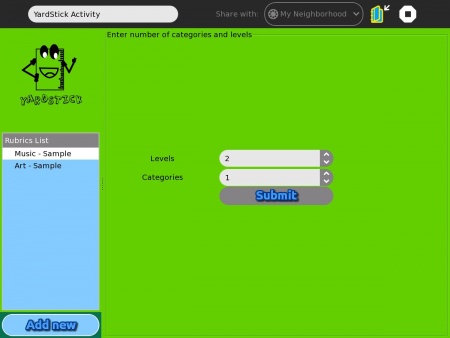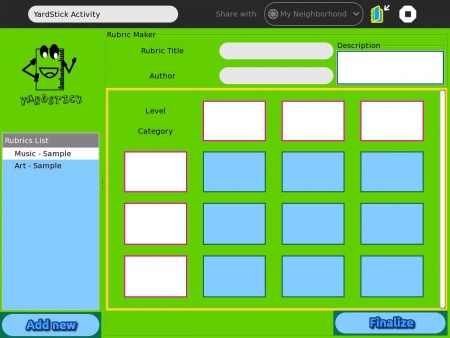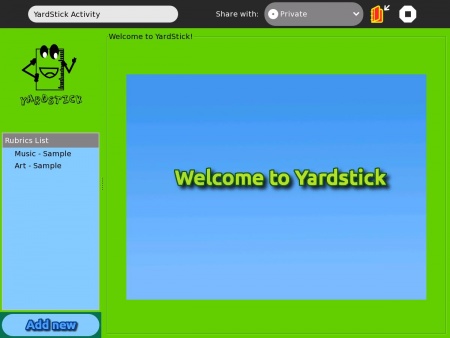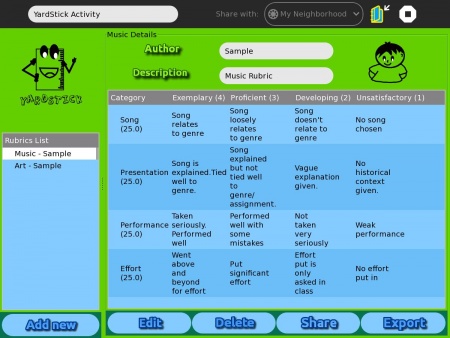Difference between revisions of "Activities/Yardstickactivity"
Jump to navigation
Jump to search


| Line 16: | Line 16: | ||
<br /> | <br /> | ||
<br /> | <br /> | ||
| + | |||
| + | [[File:Yardstick_-_Figure_2.jpeg|450px|thumb|left|Figure 2 In adding a rubric, you need to press the “Add New Rubric” button at the lower left-hand side of the activity. The first step is to indicate the number of levels and categories. To do this, use the “spin box” provided in the page. Use the arrow pointing up to increment the number in the field and the arrow pointing down to decrement. You can also type in the number of levels and categories in the field provided. For this version of YardStick, the maximum number of rows and columns are set to 9. Figure 1 shows the page where the user needs to input the number of levels and categories. ]] | ||
| + | |||
| + | <br /> | ||
| + | <br /> | ||
| + | |||
| + | [[File:Yardstick_-_Figure_3.jpeg|450px|thumb|left|Figure 3 shows the page where the user needs to build the rubric. The activity will ask for a rubric name, rubric author, description, levels (in the columns) and categories (in the rows). The user also needs to describe each level in each category. This will define each level per category for grading purposes. Clicking on the “Finalize” button will save the rubric. It will now be listed in the left-hand side of the activity (Rubrics List).]] | ||
| + | |||
| + | <br /> | ||
| + | <br /> | ||
| + | |||
| + | [[File:Yardstick_-_Figure_4.jpeg|450px|thumb|left|Figure 4 The user can view a specific rubric by selecting a rubric through the “Rubrics List” in the left-hand side of the activity. Figure 3 shows the page of the “view rubric” functionality. From this page, the user can edit, delete or send the rubric to the ScorePad activity.]] | ||
| + | |||
| + | <br /> | ||
| + | <br /> | ||
| + | |||
| + | [[File:Yardstick_-_Figure_2.jpeg|450px|thumb|left|Figure 2 ]] | ||
| + | |||
| + | <br /> | ||
| + | <br /> | ||
| + | |||
| + | [[File:Yardstick_-_Figure_2.jpeg|450px|thumb|left|Figure 2 ]] | ||
Revision as of 17:22, 17 May 2012
The YardStick activity serves as a rubric-maker tool. This activity creates new rubric that can be used in the ScorePad activity ([1]). The rubric created in this activity can be sent to the database of the ScorePad activity. Then the ScorePad activity can use this rubric to evaluate other people’s project. The YardStick activity needs the following information: rubric name, rubric author, description of the rubric, number of rows and columns (for the number of criteria and level, respectively), the levels, the criteria for grading and the descriptions for each level in every criterion. The functionalities of the YardStick Activity are the following:
- Add rubric
- View rubric
- Edit rubric
- Delete rubric
- Add numerical points in every level of every category and the percentage of each category
- Export rubric to ScorePad activity.
Screen Captures

Figure 2 In adding a rubric, you need to press the “Add New Rubric” button at the lower left-hand side of the activity. The first step is to indicate the number of levels and categories. To do this, use the “spin box” provided in the page. Use the arrow pointing up to increment the number in the field and the arrow pointing down to decrement. You can also type in the number of levels and categories in the field provided. For this version of YardStick, the maximum number of rows and columns are set to 9. Figure 1 shows the page where the user needs to input the number of levels and categories.

Figure 3 shows the page where the user needs to build the rubric. The activity will ask for a rubric name, rubric author, description, levels (in the columns) and categories (in the rows). The user also needs to describe each level in each category. This will define each level per category for grading purposes. Clicking on the “Finalize” button will save the rubric. It will now be listed in the left-hand side of the activity (Rubrics List).

